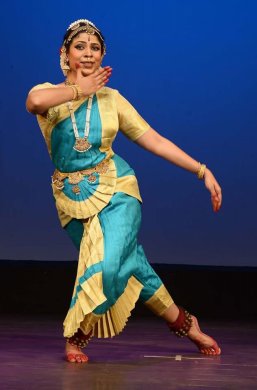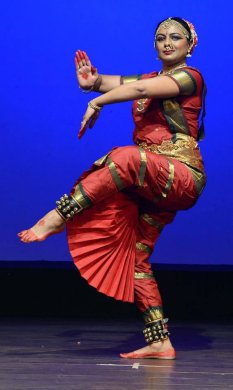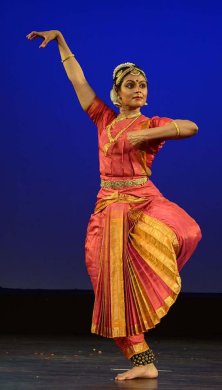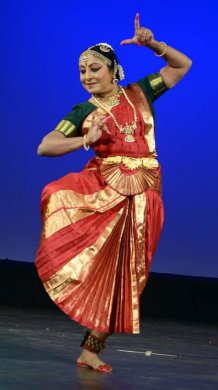
|   |

|   |
NRI Festival: Variegated expressions - Satish Suri e-mail: satishism@yahoo.co.in Photos: Shandilya Srivatsa January 23, 2019 The NRI Festival under the aegis of the International Arts & Cultural Foundation, presented at Seva Sadan, Bangalore, on 25th December 2018 showcased four dancers who presented their credentials in an admirable fashion.  Prakruti Hoskere Prakruti Hoskere, an architect from Maryland and having trained under Praveen Kumar, opened the proceedings with a Devi Stuthi "Ranjani mrudu pankaja lochini" comprising the four ragas - Ranjini, Sreeranjani, Megharanjini and Janaranjini - that describes the Mother Goddess with all her attributes and one who looks after the welfare of her devotees. She showed her command over the dance form with clarity and conviction. She followed with a kriti on Shiva, "Pradosha samayadi para Shiva tandava", a composition of Padmacharan in Purvi Kalyani wherein Shiva is dancing the Tandava and all of Kailash reverberates to the tala of Ganapathi. Encapsulating the several aspects of the Sandhya Tandava with the vigour of Shiva, captured with well-rehearsed movements and refined technique with the rhythmic sections enhanced the visual appeal. She concluded with a Kanakadasa composition in Ragamalika, "Baro Krishnayya" where the artist chose to explore the vatsalya bhava of Yashoda and Krishna with finesse and intensity.  Shraddha Joglekar Shraddha Joglekar, Artistic Director, Kala Awishkar Dance School (USA) presented a Natesa Kautvam in Naata with befitting expressions and her experience of yoga stood out in good extensions and lines. The jatiswaram in Abhogi had all the markings of good training and sense of rhythm. Having trained under Kalanidhi Narayanan, her next piece explored the Navarasa Sloka "Shive Shrungara" wherein the navarasas were seen through the eyes of Parvati. The choreography of Kalanidhi lent a charming facet to the exposition by the artist. In the ashtapadi "Yahi Madhava Yahi Keshava" an angry Radha questions the veracity of the statements of Krishna when the telltale signs of his dalliance with the other woman are clearly visible and asks him to go away. Capturing the mood of the composition in its entirety, Shraddha showcased her strength in abhinaya. She concluded with a javali in raga Kapi, "Pancha Sharamula" which describes Krishna as one who plays with 16000 gopis and inspite of all his mischief they are still endeared to him. Enacted with a sense of humour and lightheartedness, the rendition proved noteworthy.  Jyotsna Vaidee Jyotsna Vaidee, Aristic Director, Samudra Dance Creations from California, trained under Prof C.V Chandrasekhar and Bragha Bessell, started with a Mallari in Gambhira Nattai enacting the temple deity in procession and the associated rituals of worship. The dance movements showcased several different musical instruments blending them with the grace of pure nritta. She followed it with 'Varsha' wherein the devotee prays to Goddess Bhavani to shower rain on the parched earth. She explored the Muthuswamy Dikshitar composition "Ananda amrutha kashye" in Amrithavarshini to illuminate her narrative qualifying it with distinct expressions and refined nritta. 'Ardhanareeswara' explores the dualistic principle of Shiva and Parvati with epithets of Shiva adorned with ash and the sky as his garment and wears a snake around his neck and a garland of skulls. Parvati on the other hand, is the epitome of beauty with jewels and a garland of flowers smeared with sandalwood paste, the unified tatwa of representing Purusha and Prakriti, as the ultimate sustenance of creation. The artist combined verse and details of the movement of the tandava of Shiva meeting the lasya of Parvati delineating layers of meaning and philosophy with aplomb. The javali in Purvi Kalyani "Nee matale mayanura sami" showcased the artist's forte in abhinaya of the khandhita nayika who recalls memories of how he had mesmerised her with promises of jewels and adornments many times over. The rendition illuminated the nuances and beauty of the sahitya with evocative expressions. Jyotsna concluded with a thillana, a composition of Swati Thirunal in raga Dhanashree which highlighted her command over the medium.  Tara Priyadarshini Bikkasani The final artist for the day was the Kalakshetra alumni Tara Priyadarshini Bikkasani, Artistic Director of Rudram Dance Company (USA). Her opening Devi kriti "Omkara roopini" composed by Varijashree Venugopal, a talented flautist, incorporated several aspects of the Devi and many epithets describing her many manifestations - as the Satchidanandaroopini for the ultimate salvation of humanity, the destroyer of evil as Mahishasura Mardhini, the one who wards off all sins and one who blesses the guru with salvation. Interspersed with rhythmic syllables, the presentation was aesthetically synchronised and validated her competence. The Shiva Stuthi carried the memory of nostalgia. Composed by late S. Rajaram and choreographed by Krishnaveni, the composition "Shiva Shankar Mahadeva Parvati Pati Shambo" was brought to life eloquently by the artist. The melodic strains of the live orchestra comprising Nandakumar Unnikrishnan (vocal), Prasanna (nattuvangam), Jayaram Kikkeri (flute) and Janardhan (mridangam) enriched the vitality and execution by the dancer. In his ardent devotion, the devotee addresses Shiva by the many names he is known by. Perfect footwork and striking jathis characterised the presentation. The soulful singing of Nandakumar elevated the status of the performance. The epithets of Shiva woven into the choreography were well rendered. The artist concluded with a padam in Surutti, "Varattum swamy varattum Kumaraswamy" choreographed by Rukmini Devi Arundale. The artist's rendition emphasised on technique and strength and provided depth and dimension in the delineation of the piece. Bangalore based Satish Suri is an avid dance rasika besides being a life member of the Music and Arts Society. |